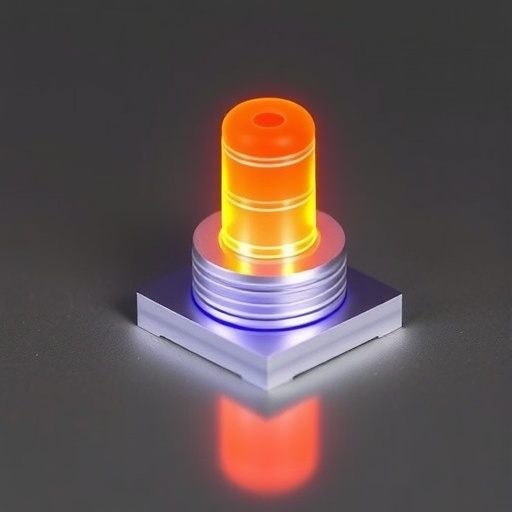In a groundbreaking advancement at the interstice of modern medicine and technology, researchers have recently introduced a novel soft magnetoelastic sensor designed to detect fatigue in real time. Fatigue, a multifaceted condition often manifested through a decline in both mental and physical performance, is typically evaluated through a variety of means, including self-reported questionnaires, electroencephalography, and camera-based technologies. Yet, these existing methodologies are largely confined to laboratory environments, posing significant barriers to widespread accessibility and practical applications in everyday life. The innovative sensor, however, holds promise for transformative changes in how we monitor and assess fatigue in more practical settings.
The sensor’s unique design integrates a magnetomechanical coupling layer crafted from a silicone rubber matrix embedded with micromagnets, along with a sleek conductive gold coil laid upon a thin thermoplastic elastomer layer. This sophisticated hybrid enables the sensor to translate eye movements — specifically eye-blink parameters — into high-fidelity electrical signals, thus converting the human body’s subtle physical responses into quantifiable data pertinent to fatigue assessment. The sensor’s structural attributes endow it with significant usability, making it ideally suited for continuous monitoring without sacrificing comfort or functionality.
Among its remarkable specifications, the sensor exhibits an impressive Young’s modulus of 200 kPa, making it malleable enough to wrap comfortably around the delicate contours of the upper eyelid without causing discomfort to the user. Furthermore, its stretchability reaches an astounding 530%, allowing it to accommodate a wide range of eye movements typically experienced in daily activities. The pressure sensitivity is also noteworthy, quantified at 0.2 µA kPa⁻¹, which opens avenues for detecting even the most subtle variations in eye movements.
What sets this sensor apart from its predecessors is its thin membrane structure, which ensures that it adheres conformally to human eyelid tissue. This characteristic is vital, as maintaining intimate contact with the eyelid during diverse eye movements ensures accurate readings. Unlike traditional fatigue monitoring methods that often require cumbersome equipment or invasive procedures, this sensor allows for seamless integration into daily life, offering users the ability to monitor fatigue levels discreetly and conveniently.
To augment the sensor’s capabilities, its data can be processed alongside a one-dimensional convolutional neural network. This advanced processing technique enables the recognition of minute eye movements that would otherwise go unnoticed, significantly heightening the sensor’s efficacy in categorizing fatigue levels. Impressively, the combination of this sensor technology and sophisticated data analysis achieves an outstanding accuracy of 96.4%, derived from six distinct eye-blink parameters. Such precision is a game-changer in the realm of fatigue monitoring and places this technological advance at the forefront of wearables designed for health and wellness.
This innovation does not merely represent a technological triumph; it paves the way for future research into fatigue management and interventions that could fundamentally enhance quality of life. By understanding individual fatigue levels in real time, users could tailor their activities and engage in timely interventions, such as rest or relaxation techniques, to combat fatigue’s detrimental effects. This not only fosters greater awareness but could lead to improved performance in professional and personal domains.
The implications for clinical applications are equally compelling. Healthcare professionals could leverage the insights provided by this sensor in monitoring patients who experience chronic fatigue or other fatigue-related disorders. Such real-time feedback could enhance treatment efficacy, offering tailored health advice that aligns more closely with individual patient needs. The seamless nature of the technology also encourages sustained engagement, as users are more likely to adhere to monitoring protocols when the method is unobtrusive and user-friendly.
Moreover, it opens the floodgates for further exploration into other physiological signals that may correlate with fatigue, inviting a broader investigation into how fatigue impacts various bodily functions beyond cognitive and physical domains. With a reliable sensor that captures real-time data, researchers can unravel the intricate tapestry of fatigue’s effects on human health.
As this technology evolves, it also speaks to broader societal trends toward integrating smart devices in personal healthcare. The shift from passive observation to active, real-time monitoring aligns with a progressive understanding of health that encompasses personal responsibility and preventative care. Wearable technology has already begun transforming how we approach fitness and health management, and this new magnetoelastic sensor heralds a significant evolution within that trend.
In synthesizing traditional fatigue assessment techniques with cutting-edge sensor technology, this research illustrates how interdisciplinary collaboration can yield solutions that address real-world challenges. The collaborative efforts among engineers, material scientists, and healthcare professionals exemplify the synergy necessary to push the boundaries of innovation and find practical solutions for persistent health issues.
As this technology transitions from the research phase toward practical application, the potential for societal impact becomes increasingly tangible. Whether worn as a fashionable accessory or integrated into existing health monitoring wearables, this sensor is poised to revolutionize how individuals manage and perceive fatigue, enhancing overall wellness in an increasingly demanding world.
In conclusion, as we continue to navigate through historically unprecedented levels of stress and responsibility, the introduction of this soft magnetoelastic sensor emerges as an essential tool. It offers not just a novel approach to understanding fatigue but also empowers individuals and healthcare providers alike to engage in meaningful interventions. By harnessing the power of technology to address unique health challenges, we stand on the cusp of a new era in personal health monitoring, underscoring the endless possibilities that lie ahead.
Subject of Research: Fatigue monitoring through innovative sensor technology
Article Title: A soft magnetoelastic sensor to decode levels of fatigue
Article References:
Xu, J., Duan, C., Wan, X. et al. A soft magnetoelastic sensor to decode levels of fatigue.
Nat Electron 8, 709–720 (2025). https://doi.org/10.1038/s41928-025-01418-x
Image Credits: AI Generated
DOI: https://doi.org/10.1038/s41928-025-01418-x
Keywords: Sensor technology, fatigue monitoring, magnetoelastic material, wearable health devices, real-time data analysis.
Tags: advancements in medical technologycomfort in wearable sensorscontinuous fatigue monitoring solutionseye movement fatigue measurementhigh-fidelity electrical signal translationinnovative fatigue assessment methodsmagnetoelastic sensor technologymagnetomechanical coupling in sensorspractical applications of fatigue sensorsreal-time fatigue detectionsilicone rubber matrix applicationswearable health monitoring devices






